Here’s a little review of steps involved in writing and publishing a blog post:
Once you have written the body of the post, it’s time to check for effectiveness:
Before you publish, here are a few smart things to check for: Read More→
Here’s a little review of steps involved in writing and publishing a blog post:
Once you have written the body of the post, it’s time to check for effectiveness:
Before you publish, here are a few smart things to check for: Read More→
 Print magazines are alive and well, but they’re in transition. The ones that are thriving are customer magazines, designed to be helpful and relevant to consumers while delivering marketing messages and building brand loyalty.
Print magazines are alive and well, but they’re in transition. The ones that are thriving are customer magazines, designed to be helpful and relevant to consumers while delivering marketing messages and building brand loyalty.
Yesterday I led a workshop in the Netherlands at Media Partners Group. They specialize in both Dutch and English language publications for large companies, like Shell Oil and Heineken Beer, among others. Here’s the way they describe themselves:
MediaPartners Group inspires with text and images. We build relationships, stimulate sales and promote loyalty. We reach clients or employees by performing the unexpected, but without being creative for creativity’s sake.
Our dedicated team of specialists in the areas of strategy, design, content, copy, account and project management provide clients with sponsored magazines, web design, direct marketing solutions, in store communications, advertising and loyalty programmes for internal and external target groups.
As almost everywhere in Holland, professional people all speak English. There were several staff members from the UK, which is why they are able to create high quality communications for huge global corporations. The other reasons are because they are a group of talented smart people who love their work. Read More→
 There aren’t many conferences that I’d fly 5700 miles to get to, but the 5th International Customer Media Congress looks as if it’s going to be another smash hit. I’ve been invited to speak, by uber-publishing-content-marketing icon, Sak van den Boom.
There aren’t many conferences that I’d fly 5700 miles to get to, but the 5th International Customer Media Congress looks as if it’s going to be another smash hit. I’ve been invited to speak, by uber-publishing-content-marketing icon, Sak van den Boom.
Somewhow in my family it meant you were in real trouble when you were “in dutch…”
Met wat voor tekst scoor je nu het beste op het web. Internetguru Patsi Krakoff uit Mexico blogt dagelijks en heeft wereldwijd veel volgers. Ze komt speciaal voor het jubleumcongres naar Haarlem om haar kennis te delen. 11 topvrouwen in marketing en communicatie op het netwerkcongres over customer media in de Philharmonie in Haarlem. Verzeker jezelf van een plaats. Schrijf nu in.
I don’t suppose I’ll see you there, but consider yourself invited. Here’s the line-up: 11 top notch experts in creating content that engages the hearts and minds of customers through custom publishing. Who says print is dying? Read More→
 If you’re going to create content that grabs readers’ attention, sparks emotional engagement, and gets them to take action, you need to know what makes people tick. Although traditionally the heart is referred to as “the ticker,” it’s the brain that runs the show.
If you’re going to create content that grabs readers’ attention, sparks emotional engagement, and gets them to take action, you need to know what makes people tick. Although traditionally the heart is referred to as “the ticker,” it’s the brain that runs the show.
Your brain:
This last tidbit of information is key. Although it’s a small organ, it is a huge consumer of energy. The way it conserves energy is by going on automatic pilot, similar to the way Kindle and laptops go into sleep mode.
This is why the brain prefers to not have to think. If it can rely on the subconscious parts of the brain, it will, because this part decides without thinking, using intuition. It doesn’t have to use up precious energy reserves.
Your brain is responsible for a huge number of functions:
Feelings Come First
The emotional parts of the brain are larger than the rational part. Feelings come first, and are processed five times more rapidly in the subconscious brain than in the conscious, thinking brain. Read More→
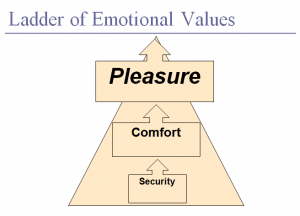 What emotions are people seeking to satisfy online? What can we understand about human motivations and values in order for content marketing to work?
What emotions are people seeking to satisfy online? What can we understand about human motivations and values in order for content marketing to work?
Maslow’s famous hierarchy of needs tells us we are motivated to satisfy our basic needs first (food, shelter, clothing), before we seek to obtain satisfaction for social, intellectual and spiritual needs.
A similar hierarchy of emotional values exists. As incoming information from web and blog pages enters the brain and is processed, our emotional centers assign values to offers.
Brain science, along with studies on decision making from behavioral economics, has shown that people often don’t use logical reasoning. Instead they go with their gut reactions. They make decisions based on feelings.
Later, when that leads to a buying decision, people justify their actions with rational logic and intellectual “alibis.”
At the lowest level, people have a desire for security. The next thing they seek is comfort. At the top of the ladder, people will pay the most to satisfy a desire to experience pleasure.
Although these values are all emotional, rationality plays a part. Online, an offer must work properly for consumers to feel secure. A marketing offer also provides comfort through ease of purchase, and also by providing reasons to defend the purchase to friends and family. But rationality is never the deciding factor. Read More→
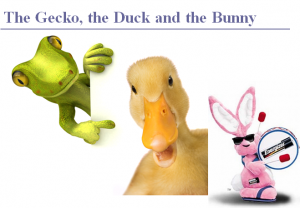 What are two key elements to creating content that get results? I stumbled across an interesting quote on a site that gets to the heart of content marketing matters:
What are two key elements to creating content that get results? I stumbled across an interesting quote on a site that gets to the heart of content marketing matters:
“Evolution tends to favor action over thinking. That hasn’t changed. Emotion controls the mind as it did when humans first came on the scene.
“People react much more emotionally than companies dare to think. Purchasing decisions are never driven by logic alone. Emotion and narrative are key, they are the very structure of mind and of human nature.
“All successful marketing campaigns – whether using primeval or post-digital technologies — have responded to this phenomenon.” ~ Dr. Bob Deutsch, cognitive anthropologist, BrainSells.com
Emotion and narrative… Remember these two crucial keys to content marketing.
I’m going to take a broader view and relate narrative to branding. Branding tells a story in the blink of an eye.
How can brands, which are designed to make an instant visual and emotional impact, take advantage of emotions and narrative to connect with consumers emotionally?
I am reading Dan Hill’s excellent book Emotionomics. He says this about branding and narrative:
“…brand equity accrues to the extent that a company’s brand story provides the two main components of a successful story. The first is an attractive personality. The second is positive signature associations by which the company becomes familiar and comfortable to members of its target market.”
In other words, a company’s brand works when: Read More→
 You’re probably already familiar with the right and left brains… but what about the female brain? How does it differ from a male brain, and what does this mean for content marketers?
You’re probably already familiar with the right and left brains… but what about the female brain? How does it differ from a male brain, and what does this mean for content marketers?
First, let’s review the right and left brain functions…
The left hemisphere is the center of linear thinking such as language, logic, and mathematics.
The right hemisphere is the center of abstract conceptual thoughts such as art, music, creativity and inspiration.
Corpus Collosum: The two hemispheres have neurons that connect the two sides, so that both are involved in much of what we do.
In females, this connection is much stronger. There are many more neurons connecting the two hemispheres, which accounts for her greater ability to operate out of both sides of the brain. Men tend to use predominantly one side or the other, which account for their ability to focus and compartmentalize.
This is one of the primary differences in male and female brains, there are others.
Female brains have more developed language centers in the brain. A man says approximately 2,000 words a day, a woman 7,000. That’s 3 1/2 times as much talking…
A woman has more active mirror neurons, and a greater capacity to experience empathy.
Which gender do you think will respond better to a lot of content? To social opportunities? To social media participation? Hmmmm…
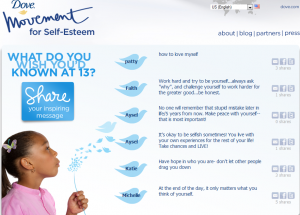 The Dove.com site is one of the better sites that understand content marketing to females. Their site is as much about women as it is about soap.
The Dove.com site is one of the better sites that understand content marketing to females. Their site is as much about women as it is about soap.
I don’t know many females who aren’t interested in self-esteem issues, who haven’t had their own issues with body image, do you?
This site appeals to us because of it’s attention to:
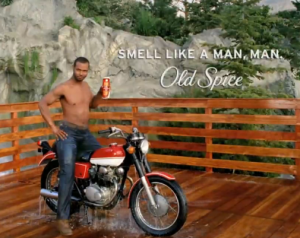 What can we learn from brain science about how to market to men?
What can we learn from brain science about how to market to men?
79% of men are alienated and barely able to recognize themselves in the ads portraying their gender (Business Week, 2006)
The Old Spice site has some great TV clips that do a good job of appealing to men’s views of themselves, using humor and exaggerations of stereotypes.
Here’s what else grabs the attention of male brains…
Attention: They live in the ‘now.’ They are concrete thinkers that like to consummate, finish. Men are goal-oriented. A male axiom is “get it done.”
Men are interested in power and in looking good, even more than being good.
Time– Men tend to hone in, more quickly than women, on what they’re looking for. Men are not browsers. A male motto, “Get what I want and move on.” Provide clear links to what they are looking for.
Causality– Men are concrete and tend to tightly focus their awareness. Their notion of cause and effect is linear and men are visually-oriented because of this concrete perspective.
Seeking clarity, men create absolute distinctions: black-white, yes-no. First- last, winner-loser.
Men like to feel unique and special, and as such they will follow their gurus, heroes and sports stars and teams.
Celebrity endorsements and affiliation – If Michael Jordon wears them, they’re good enough for men.
Look at Steve Jobs, Richard Branson: If the company president is a rebel and a renegade, then others will join their cause and identify with the company and their products.
Other people – For the male it’s every man for himself. Men prize individuality and self-reliance. They conceive of other people as “my competition.“
They ask, “What will your product do to make me better than the others?”
Look at Razerzone.com, a manufacturer of PC gaming hardware such as mice. This company publishes a gaming guide to show “noobs” how to rapidly improve their online game scores. It’s a list builder that is responsible for the company going from a list of 8,000 to 200,000 in less than 2 years.
It’s their key content marketing piece, and there are others. The president, RazerGuy, has his own blog, and they have active participation on Facebook. There are even Razer fan sites built by evangelists, and many tattoo the company logo, a three-headed snake, on their bodies.
 Something’s wrong with the way marketers are trying to reach people over 65. I know this from personal experience.
Something’s wrong with the way marketers are trying to reach people over 65. I know this from personal experience.
I am learning new stuff about the brain all the time, and since I have one myself, older brains are particularly interesting to me.
If marketers don’t get wise to the way seniors perceive their marketing messages they are are in for a rude awakening. Marketing to the older brain isn’t done by showing pictures of frail people, confused people, or trying to frighten them into buying stuff.
Wake up, folks. “Seniors,” doesn’t mean senile. Older people aren’t all decrepit and stupid. Not only that, but we’ve got more of the money, honey.
Let’s just take the young seniors, those Baby Boomers who are just coming of age now. The 44 million baby boomers are maturing rapidly, and represent the richest generational cohort in history. In the US, they control 77% of all financial assets. They use ½ of all credit cards, and spend 2½ times the per capita average on discretionary purchases.
The level of spending by those over 45 will soon exceed that of people between 18 and 39 by $1 trillion US. Yet, despite these statistics, only 10 percent of all branded marketing target older consumers (Wolfe and Snyder, 2003).
I know that neither myself, my husband or any of my friends of similar ages are attracted to the way seniors are depicted in marketing messages.
Some of us don’t use a cane or a walker. We actually play sports and even dress like younger peeps.
Here are a few facts about the older brain and how it likes to be marketed to. Read More→
 Hi, my name is Suzanne Bird-Harris. I’m a WordPress consultant and online business coach. Patsi asked me to guest post on her blog, and it comes at a good time, on the heels of an interesting blog survey…
Hi, my name is Suzanne Bird-Harris. I’m a WordPress consultant and online business coach. Patsi asked me to guest post on her blog, and it comes at a good time, on the heels of an interesting blog survey…
In a recent survey, I asked readers what their biggest hurdle was when it came to blogging. Not surprisingly, 25% of respondents said they were complete blogging newbies and needed guidance on the fundamentals of blogging…the technical know-how as well as content creation strategies.
Another 55% consider themselves capable, but know they have more to learn where technical know-how and content creation strategies are concerned.
The final 20% consider themselves competent and ready for advanced topics.
But, when I asked this same group where they experienced hurdles to overcome in blogging, look at the breakdown of the answers I got: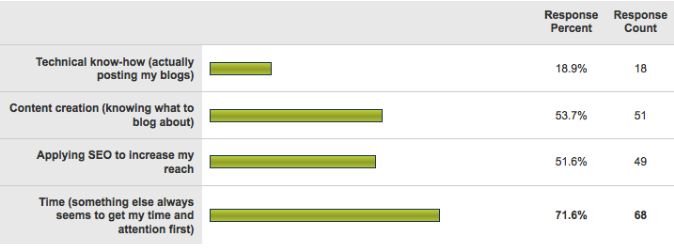
I’m not at all surprised that almost 72% see time as a major hurdle. I think we can all identify with that. But here’s the bad news:
Time is not the major hurdle you think it is. How much would ‘time’ be a factor if you knew exactly:
Mmmmm…probably a lot less than it is now, don’t you think? If you’re one of the competent 20% ready for advanced topics such as SEO, this program I’m going to suggest is likely not for you. Check what’s covered, just to be sure.
Confidence (or lack of, rather) is the major hurdle.
Let’s face it, feeling like you don’t know what you’re doing when it comes to blogging really stinks. Besides making you think your learning curve is steep and endless, no one I know wants to do anything as public as blogging until they’re confident they know what they’re doing.
Confidence is born of knowledge and experience. But why gain them the ‘hard way’ – and in front of your audience, no less?
Would you like to move from frustrated to confident in this lifetime? How about before the New Year?
Blogging 101:
6 Weeks to Confident Blogging Read More→
Recent Comments